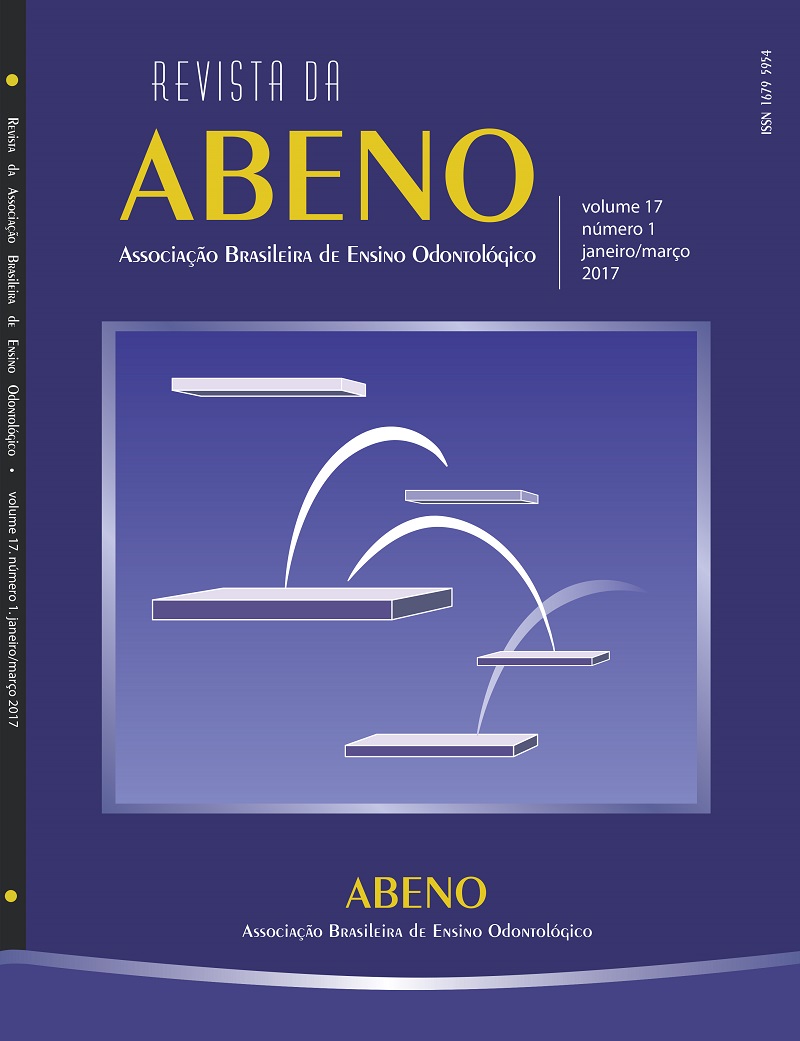E-learning in Oral Diagnosis: experience report at the University of Brasília
DOI:
https://doi.org/10.30979/rev.abeno.v17i1.358Keywords:
Dentistry. Radiology. Education, Distance. Information Technology.Abstract
E-learning can be defined as any type of educational situation in which the content is available electronically via Internet when and where people need it. Using the possibilities that virtual environment provides for education, was developed an e-module in the Moodle Platform. The aim of this study was to verify the access, performance, and acceptance of undergraduate dentistry students to use the e-module in the online activities of Oral Diagnosis Discipline at the University of Brasilia. Evaluations of content (pre and post-test), pre-test of expectation and post-test of satisfaction were designed to evaluate the content and acceptance of e-module among participants. Of the 25 initial participants, 2 completed the e-module, 11 started and did not complete, 9 did not access the platform and three did not accept to answer the post-test of satisfaction. Pre and post-test of content showed no significant data. The post-test of satisfaction showed that the students who have not accessed the e-module, or accessed and did not complete, 80% said they "did not have time to access the Platform" and 15% said they did not participate or did not complete the e-module "because it would not improve GPA or course credit number". In conclusion, although students were positive regarding the use of new methodologies, the participation was very low. The performance was similar to presential classes. Several factors influence the attitude of the students in the e-module, including rewards gain and the pedagogical form of the contents. Thus, it is up to the teacher the motivational and mediating role between learning and the virtual world.
Downloads
References
Barros WM, Altermann CDC, Alves N, Borges S, Menezes JR, Carpes PBM. Uso do Moodle como ferramenta de apoio ao ensino de fisiologia humana em cursos da área de saúde. Rev Biomotriz. 2013;7(2) :112-29
Salvador ME, Sakumoto M, Marin HF. Uso do Moodle na Disciplina de Informática em Enfermagem. J Health Inform. 2013;5(4) :121-6. (Acesso em 17 jan. 2015). Disponível em: www.jhi-sbis.saude.ws
Handal B, Groenlund C, Gerzina T. Dentistry student’s perceptions of learning management systems. Eur J Educ. 2010; 14(1):50-4.
Zhang D, Nunamaker JF. Powering e-learning in the new millennium: an overview of e-learning and enabling technology. Inform Syst Front. 2003;5(2) :207–18.
Brasil. Ministério da Educação (MEC). Portaria nº 4.059 de 10 de dezembro de 2004. DOU de 13/12/2004, seção 1, p. 34.
Christofoletti G, Fernandes JM, Martins AS, Junior SAO, Carregaro RL, Toledo AM. Grau de satisfação discente frente à utilização de métodos ativos de aprendizagem em uma disciplina de Ética em saúde. REVEDUC. 2014;8(2):188-97
Rocha, JSY. Uso de tecnologias da informação e comunicação na educação em saúde. Problematização e desenvolvi-mento. Medicina (Ribeirão Preto). 2015; 48(3):214-23. (Acesso em 21 jan. 2015). Disponível em: http://www.revistas.usp.br/ rmrp/article/view/104297.
Silva RHA, Perim GL, Abdalla IG, Costa NMSC, Lampert JB, Stella RCR. Abordagens pedagógicas e tendências de mudanças nas escolas médicas. Ver Bras Educ Med. 2009;33(Suppl 1):53-62.
Franco CP. O uso de um ambiente virtual de aprendizagem no ensino de inglês: além dos limites da sala de aula presencial [dissertação]. Programa Interdisciplinar de Pós-Graduação em Linguística Aplicada, Faculdade de Letras. Universidade Federal do Rio de Janeiro, 2009.
Barbosa MFSO, Rezende F. A prática dos tutores em um programa de formação pedagógica a distância: avanços e desafios. Interface Comunic Saúde Educ. 2006;10 (20):473-86, 2006.
Araújo IMZC, Silva JRS, D’Assunção FLC, Melo ABP. Avaliação da percepção dos alunos da disciplina de endodontia sobre o uso do Ambiente Virtual de Aprendizagem (Moodle). Uso do questionário de auto-avaliação COLLES. Rev ABENO. 2012; 12(2):163-9.
Ribeiro PS. Manual de utilização do moodle 1.9. Perfil Professor Versão 1.0. Universidade Federal do Pampa, 2010. (Acesso em 7 dez. 2014). Disponível em: https://moodle.unipampa.edu.br/file.php/1/Manual_de_utilizacao_do_Moodle_1.9_-_Manual_do_Professor_-_Versao_1.pdf
Santos GNM, Rosa EL, Leite AF, Figueiredo PTS, Melo NS. Augmented reality as a new perspective in dentistry: development of a complementary tool. Rev ABENO. 2016;16(3):19-27.
White S, Pharoah M. Radiologia Oral. Fundamentos e Interpretação. 7ª ed. Rio de Janeiro: Elsevier, 2015, 696p.
Meckfessel S, Stuhmer C, Bormann KH, Kupka T, Behrends M, Matthies H, et al. Introduction of e-learning in dental radiology reveals significantly improved results in final examination. J Cranio Maxillofac Surg. 2011;39:40-8.
Nkenke E, Vairaktaris E, Bauersachs A, Eitner S, Budach A, Knipfer C, et al. Spaced education activates students in a theoretical radiological science course: a pilot study. BMC Med Educ 2012;12: 32.
Stein CD, Eisenberg ES, O’Donnel JA, Spallek H. What Dental Educators need to understand about emerging technologies to incorporate them effectively into the educational process. J Dent Educ. 2014;78 (4):521-9.
Junior RCR, Moura MLS, Hutz CS. Adaptação brasileira da Escala de Desejabilidade Social de Marlowe-Crowne. Aval Psicol. 2004;3(2):83-92.
Galvão MF, Magalhães AV. Sistema de exercício online para apoio a aprendizagem de Medicina Legal na Universidade de Brasília. Rev Bras Educ Med. 2009; 33(1):84-91.
Peixoto RTRC, Gonçalves PVAJ, Alvim HH, Amorim HCS, Araújo AVA. O emprego das tecnologias de informação e comunicação no ensino superior: um relato de experiência sobre a oficina “Modelo Híbrido de Ensino”. Rev Docência Ens Sup. 2015;5(1):183-204.
Downloads
Published
How to Cite
Issue
Section
License
Autores que publicam nesta revista concordam com os seguintes termos:
a) Autores mantém os direitos autorais e concedem à revista o direito de primeira publicação, com o trabalho simultaneamente licenciado sob a Licença Creative Commons Attribution que permite o compartilhamento do trabalho com reconhecimento da autoria e publicação inicial nesta revista.
b) Autores têm autorização para assumir contratos adicionais separadamente, para distribuição não-exclusiva da versão do trabalho publicada nesta revista (ex.: publicar em repositório institucional ou como capítulo de livro), com reconhecimento de autoria e publicação inicial nesta revista.
c) Autores têm permissão e são estimulados a publicar e distribuir seu trabalho online (ex.: em repositórios institucionais ou na sua página pessoal) a qualquer ponto antes ou durante o processo editorial, já que isso pode gerar alterações produtivas, bem como aumentar o impacto e a citação do trabalho publicado (Veja O Efeito do Acesso Livre).


